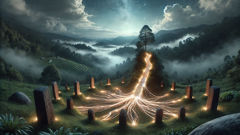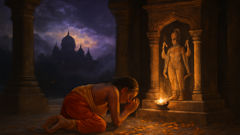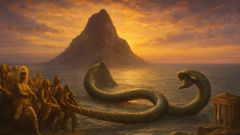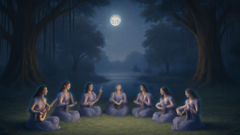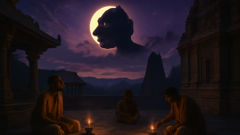Introduction
The Scottish lowlands are a landscape stitched together with stone and legend—windswept moors where mist clings to the grass and secrets echo through gnarled groves of pine. But of all Scotland’s tales, none chills the bone quite like that of Sawney Bean. In the waning years of the 15th century, when King James’s realm was fractured by feuds and superstition, the Galloway coast was gripped by a terror too monstrous to name aloud. Travelers vanished without a trace on lonely roads. Horses bolted from unseen threats beneath the moon. Small villages locked their doors at dusk, whispering of figures glimpsed at the edge of torchlight, wild-eyed and hungering. Some called them phantoms, others said wolves, but all feared what prowled in the shadows near Bennane Head. What they did not know—what no one could imagine—was that these horrors were neither ghost nor beast but a family: a clan led by one Alexander “Sawney” Bean, whose infamy would seep through centuries and stain the annals of Scotland’s darkest folklore. Their lair, a cavern hidden among sea-battered cliffs, became the cradle of a nightmare—its twisting passages echoing with the laughter of children raised far from sun or conscience, fed on the blood and flesh of innocents. This is not merely a tale of murder, nor of madness, but of a secret kingdom grown from the rot beneath the surface, and the desperate struggle to bring its monsters to light. To walk this path is to glimpse the thin edge dividing civilization from the wild, and to reckon with the darkness that sometimes grows, unchecked, in its shadows.
The Birth of a Monster: Sawney’s Descent
Long before his name became a curse, Alexander Bean was an ordinary man born into hardship in the parish of East Lothian. His father, a ditch-digger, instilled little but bitterness, and Sawney grew up resentful of authority and hungry for more than the land would yield. By his early twenties, he was already a misfit—trouble brewed wherever he went, and every petty theft or brawl was just another step down a path few dared to tread. His meeting with Agnes Douglas changed everything. Agnes, herself an outcast, was rumored to be a witch’s daughter, her eyes bright with defiance and her tongue sharper than any knife. They were drawn together by their shared disdain for law and custom, and soon, their union was sealed not in church, but in the wild, windswept country beyond the reach of kin or crown.
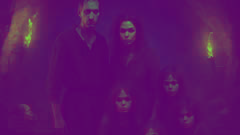
Life on the run hardened them both. The Bean couple wandered farther south, living off what they could steal, moving from the shelter of abandoned crofts to the untamed moors near Galloway. But as winter closed in and food grew scarce, desperation gnawed at them more fiercely than hunger. It was in these lean months that Sawney first crossed the final threshold. One night, in the cover of darkness, he ambushed a lone traveler on the road to Girvan. The man fought back, but Sawney’s rage was merciless. When it was done, Sawney and Agnes dragged the body to a hollow beneath a rock shelf. Agnes, never squeamish, urged him not to waste what could sustain them. In that moment, their fate was sealed.
The cave at Bennane Head became their refuge. Its narrow entrance was easily concealed by brambles and the thunder of waves, and deep within, twisting tunnels wound for hundreds of yards—a warren of darkness untouched by the sun. Here, Sawney and Agnes made their lair. Over the years, children came—first a girl, then a boy, then more, until the shadows were filled with their laughter and cries. The Bean brood grew up wild as wolves, unburdened by mercy or remorse, taught from their first steps that survival meant taking what they needed, no matter the cost.
As the family multiplied, so did their appetite and ambition. Raids on travelers became frequent and bold. The family struck with silent precision, dragging victims into the cave’s maw before their screams could carry. Bodies vanished; rumors grew. But no one could find the lair, and the Beans became phantoms—legends in the making, their story whispered in every hearth-side warning from Galloway to Ayrshire. Through the long years, the cave filled with the spoils of their crimes: coins and clothes, weapons and trinkets, piles of bones gnawed clean and left to molder in the dark. The clan thrived on fear and flesh, their numbers swelling with each passing generation. Outsiders searching for missing loved ones disappeared themselves, lost to a family that had become something far beyond human—bound not by blood alone, but by the monstrous code of survival at any cost.
The Reign of Fear: Shadows Over Galloway
For more than two decades, the Bean clan preyed on the people of Galloway with a cunning that bordered on supernatural. They watched the roads from the shelter of gorse and stone, learning the patterns of merchants and pilgrims, waiting for the unwary. When night fell and fog crept in from the sea, they struck—swift and silent, like predators born of the rocks themselves. Each ambush was carefully planned. The older sons would range ahead, signaling to their kin hidden in the bracken. The youngest children lured travelers astray with plaintive cries or sudden, fleeting glimpses in the undergrowth. Once the trap was sprung, there was no mercy. Victims vanished with barely a struggle, their horses left untethered and wagons abandoned by the roadside. The Beans picked their bones clean and left no trace save for blood staining the grass or a single shoe lost in the mud.
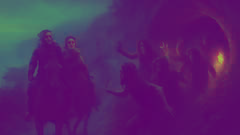
Fear thickened like fog over the villages of Ballantrae, Girvan, and Barrhill. At first, people blamed wolves or wild men, but as the missing numbered in the dozens and then hundreds, terror grew. Local lairds and even the constabulary organized patrols, but the moors yielded nothing. The Beans’ lair was too well-hidden, their tracks swept away by the tides or masked by cunning traps. Only the unlucky ever glimpsed the family—gaunt figures, pale from cave life, eyes gleaming like animals in the dark. Survivors spoke of voices echoing in the mist, of cold hands dragging them from their saddles, of shrieking laughter as the world spun away into blackness.
As the legend spread, it became a weapon all its own. Children were warned that if they strayed from the path, Sawney Bean would come for them. Travelers banded together, refusing to walk alone after dusk. Some villages built barricades and burned torches through the night, but even these precautions offered little comfort. The clan was everywhere and nowhere—always watching, always hungry. The landscape itself became complicit in their crimes: the cliffs offering concealment, the tides erasing evidence, the mist cloaking their every move. And all the while, deep in their labyrinthine cave, the Beans lived in a twisted parody of family life. Agnes presided over feasts by torchlight, her children gnawing on bones as tales of the outside world drifted in like a distant dream. They grew strong on stolen life, hardened by isolation and bound by a secret more terrible than death.
Yet even as the Beans thrived on fear, cracks began to show. Greed and hunger drove them to riskier raids. Sometimes they attacked groups too large or left evidence in their haste—a torn cloak, a bloodied dagger, a patch of hair snagged on a bramble. The outside world was changing, too. King James VI’s agents grew restless with tales of lawlessness in his domain. Whispers of the Bean clan reached Edinburgh, carried by frightened merchants and grieving families. What began as rumor became investigation, and soon, the stage was set for a reckoning.
The Fall of the Clan: Justice from the Shadows
It was a night like many before—moonless, thick with mist—when the Bean clan finally overreached. Their target was a wedding party returning to Girvan after celebrating in Ballantrae. The group was large and boisterous, but separated by revelry and drink. Sawney’s sons attacked with typical ferocity, but this time, one man fought back. Armed with sword and pistol, he cut down two of the attackers before escaping on horseback, bloodied but alive. For the first time, a survivor carried word not just of an attack, but of faces—faces pale and wild, twisted by hunger and hate.
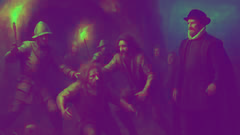
The news reached Edinburgh in a matter of days. King James VI, incensed by tales of lawlessness and affronted by rumors that his subjects believed in monsters more than in his justice, gathered an armed retinue and rode south at the head of a hundred men. Hunters, soldiers, and hounds swept across Galloway in a dragnet unseen before. Villagers joined them, emboldened by royal presence and burning for retribution. The search stretched for days, with every cave, every hollow, every thicket explored by torchlight. At first, the Beans watched from the shadows, confident in the secrecy of their lair. But hunger and fear led to mistakes.
It was a pack of hounds that found them at last. Drawn by the stench of decay seeping from a fissure in the rock, they howled and clawed at the brambles concealing the entrance. Soldiers hacked away the brush and forced their way inside, torches smoking in the cold air. What they found within became legend. The cavern’s floor was slick with blood. Piles of bones filled side chambers—hundreds of skulls stacked in mute testimony to decades of horror. The Beans fought like cornered animals, shrieking and biting, but against steel and musket they fell quickly. Sawney himself, gaunt and wild-eyed, tried to flee deeper into the tunnels but was dragged out kicking and cursing. Agnes spat at her captors, her children weeping or snarling at their chains.
The trial was swift and public—a spectacle meant to purge the land of evil and restore order. The evidence was overwhelming; no one could deny the horror uncovered in those caves. The entire clan—men, women, and children—were condemned to death. Sawney and his sons had their hands and feet severed before being left to bleed; Agnes and her daughters were burned at the stake. The crowd cheered and jeered as centuries of fear gave way to rage and relief. Yet even in death, the Beans remained a caution—a reminder of what festers in darkness when justice sleeps. Their story passed into legend, a warning that echoes across the centuries: beware the shadows beyond the firelight, for sometimes, monsters are only human after all.
Conclusion
The legend of Sawney Bean endures not only because of its horror but because it strikes at something deeper—an age-old anxiety about what lurks just beyond the edges of civilization. The Galloway coast has long since tamed its wilds, and the cavern where the Beans once hid is now little more than a curiosity to passing hikers. Yet the story lingers in the stones and in the wary glances of those who remember. It reminds us that darkness can grow unnoticed when fear is allowed to fester and that even the most civilized societies are only ever a few steps from savagery when law and light are absent. Whether Sawney Bean truly existed or whether he was a bogeyman conjured by a fearful age, his tale remains a powerful symbol—a warning that monsters are made, not born, and that they thrive in places where hope and justice are denied. In the end, Scotland reclaimed its peace not simply by rooting out evil but by reaffirming its belief in community, vigilance, and the unbreakable bonds of kinship. And so, as shadows lengthen over the moors each twilight, one might still hear the whispered caution: stay close to the path, keep your fire burning bright, and remember what waits if you stray too far from the light.



